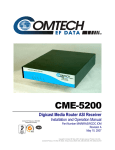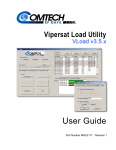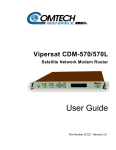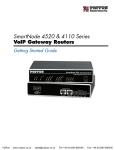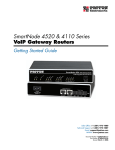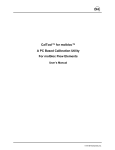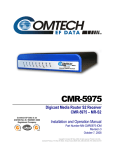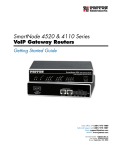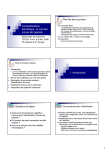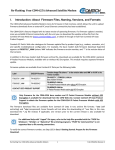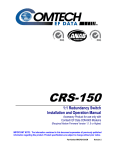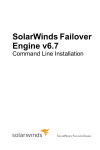Download mn_mrs2asidc_revA
Transcript
CMR-5970 / CMR-5990 Comtech EF Data is an ISO 9001 Registered Company Digicast Media Router S2 Receiver CMR-5970 – MR-S2 CMR-5990 – MR-S2-ASI Installation and Operation Manual Part Number MN/MRS2ASIDC.IOM Revision A May 10, 2007 Copyright © Comtech EF Data, 2007. All rights reserved. Printed in the USA. Comtech EF Data, 2114 West 7th Street, Tempe, Arizona 85281 USA, (480) 333-2200, FAX: (480) 333-2161 Table of Contents PREFACE .....................................................................................................................VII Customer Support....................................................................................................................... vii About this Manual ..................................................................................................................... viii Reporting Comments or Suggestions Concerning this Manual............................................... viii Conventions and References ..................................................................................................... viii Cautions and Warnings ............................................................................................................ viii Metric Conversion ..................................................................................................................... ix Recommended Standard Designations ...................................................................................... ix Trademarks ................................................................................................................................ ix Electromagnetic Compatibility (EMC) Compliance ................................................................ ix Emissions Compliance............................................................................................................... ix EN61000 Compliance................................................................................................................ ix Safety Compliance .........................................................................................................................x EN60950 Compliance..................................................................................................................x Low Voltage Directive (LVD).....................................................................................................x Warranty Policy ........................................................................................................................... xi Limitations of Warranty............................................................................................................. xi Exclusive Remedies .................................................................................................................. xii CHAPTER 1. INTRODUCTION................................................................................ 1–1 1.1 Introduction....................................................................................................................1–1 1.2 Standard Features..........................................................................................................1–2 1.3 Performance ...................................................................................................................1–3 1.4 Configurations................................................................................................................1–3 1.5 Specifications ..................................................................................................................1–4 1.6 Terminology....................................................................................................................1–6 i Digicast Media Router S2 Receiver CMR-5970 (MR-S2) & CMR-5990 (MR-S2-ASI) Revision A MN/MRS2ASIDC.IOM CHAPTER 2. INSTALLATION & INITIAL CONFIGURATION ....................................2-1 2.1 Major Assembly ............................................................................................................. 2-1 2.2 Unpacking....................................................................................................................... 2-1 2.3 Installation ...................................................................................................................... 2-2 2.4 Initial Configuration...................................................................................................... 2-3 CHAPTER 3. INTERFACE PINOUTS .........................................................................3-1 3.1 Pinout Overview............................................................................................................. 3-1 3.2 DC Power........................................................................................................................ 3-1 3.3 RJ-45 Ethernet ............................................................................................................... 3-1 3.4 RJ-12 Redundancy......................................................................................................... 3-2 3.5 RJ-12 Terminal .............................................................................................................. 3-2 3.1 BNC ................................................................................................................................. 3-2 3.6 ASI (Typical RX and TX) – MR-S2-ASI Only............................................................ 3-2 3.7 F-Type L-Band ............................................................................................................... 3-2 CHAPTER 4. 4.1 DEVICE MANAGEMENT VIA USER INTERFACES ..........................4-1 Introduction.................................................................................................................... 4-1 4.2 Web Interface ................................................................................................................. 4-1 4.2.1 Administrative Configuration .................................................................................. 4-2 4.2.2 Syslog Configuration ............................................................................................... 4-4 4.2.3 Network Configuration ............................................................................................ 4-5 4.2.4 Egress Configuration (MR-S2-ASI only) ................................................................ 4-6 4.2.5 IGMP Configuration ................................................................................................ 4-7 4.2.6 Unicast Routing Configuration ................................................................................ 4-8 4.2.7 MPE/IP Configuration (Tuner or MR-S2-ASI only) ............................................... 4-9 4.2.8 Tuner MPEG TS Route Configuration .................................................................. 4-10 4.2.9 Service Filter Route Configuration (MR-S2-ASI only)......................................... 4-12 4.2.10 Tuner Configuration............................................................................................... 4-13 4.2.11 Tuner Statistics....................................................................................................... 4-16 4.3 Terminal Interface ....................................................................................................... 4-18 4.3.1 Main Menu............................................................................................................. 4-19 ii Digicast Media Router S2 Receiver CMR-5970 (MR-S2) & CMR-5990 (MR-S2-ASI) Revision A MN/MRS2ASIDC.IOM 4.3.2 Administration Menu ............................................................................................. 4-19 4.3.2.1 Port Number Configuration ........................................................................... 4-19 4.3.3 ASI Configuration Menu (MR-S2-ASI only) ........................................................ 4-20 4.3.3.1 ASI MPE/IP Configuration Menu (MR-S2-ASI only) .................................. 4-20 4.3.3.2 ASI Service Filter Configuration Menu (MR-S2-ASI only) ......................... 4-21 4.3.3.3 ASI MPEG TS Configuration Menu (MR-S2-ASI only) .............................. 4-21 4.3.4 IGMP Configuration Menu.................................................................................... 4-22 4.3.5 Egress Configuration Menu (MR-S2-ASI only).................................................... 4-22 4.3.6 Stats Menu ............................................................................................................. 4-23 4.3.6.1 DMA Stats Menu ........................................................................................... 4-24 4.3.6.2 Ethernet Stats Menus ..................................................................................... 4-24 4.3.6.3 ASI Stats menu (MR-S2-ASI only) ............................................................... 4-25 4.3.6.3.1 ASI MPE/IP Stats Menu ............................................................................ 4-25 4.3.6.3.1.1 ASI Detailed MPE/IP Stats Menu....................................................... 4-26 4.3.6.3.1.2 ASI Detailed MPE/IP Advanced Stats Menu ..................................... 4-26 4.3.6.3.2 ASI MPEG TS Stats Menu......................................................................... 4-27 4.3.6.3.2.1 Detailed ASI MPEG TS Stats Menu................................................... 4-27 4.3.6.3.2.2 Detailed ASI MPEG TS Advanced Stats Menu.................................. 4-28 4.3.6.3.3 ASI Service Filter Stats Menu.................................................................... 4-28 4.3.6.4 Tuner Stats Menu........................................................................................... 4-29 4.3.6.4.1 Tuner MPE/IP Stats Menu ......................................................................... 4-29 4.3.6.4.1.1 Detailed Tuner MPE/IP Stats Menu ................................................... 4-30 4.3.6.4.1.2 Detailed Tuner MPE/IP Advanced Stats Menu .................................. 4-30 4.3.6.4.2 Tuner MPEG TS Stats Menu ..................................................................... 4-31 4.3.6.4.2.1 Detailed Tuner MPEG TS Stats .......................................................... 4-31 4.3.6.4.2.2 Detailed Tuner MPEG TS Advanced Stats Menu .............................. 4-32 4.3.6.4.3 Detailed Tuner Stats Menu......................................................................... 4-32 4.3.7 Network Configuration Menu................................................................................ 4-33 4.3.8 Unicast Routing Configuration Menu.................................................................... 4-33 4.3.9 Tuner Menu............................................................................................................ 4-34 4.3.9.1 Tuner Configuration Menu ............................................................................ 4-34 4.3.9.2 Tuner MPE/IP Configuration Menu .............................................................. 4-35 4.3.9.3 Tuner MPEG TS Configuration Menu .......................................................... 4-35 4.3.9.4 Tuner Service Filter Configuration Menu (MR-S2-ASI only) ...................... 4-36 4.4 Telnet Interface ............................................................................................................ 4-37 4.5 Trivial File Transfer Protocol (TFTP)....................................................................... 4-38 4.6 Simple Network Management Protocol (SNMP) (Future)....................................... 4-39 APPENDIX A. SOFTWARE UPGRADE ................................................................. A–1 A.1 Introduction...................................................................................................................A–1 A.2 Web Interface ................................................................................................................A–2 iii Digicast Media Router S2 Receiver CMR-5970 (MR-S2) & CMR-5990 (MR-S2-ASI) A.3 Telnet or Terminal Interface .......................................................................................A–3 APPENDIX B. B.1 Revision A MN/MRS2ASIDC.IOM IP ROUTING SUPPORT.................................................................. B–1 Introduction...................................................................................................................B–1 B.2 IP Configuration ...........................................................................................................B–1 B.2.1 Unicast Routing ......................................................................................................B–2 B.2.2 Multicast Routing....................................................................................................B–2 B.3 Section Packing .............................................................................................................B–3 APPENDIX C. SYSTEM LOG CONFIGURATION .................................................. C–1 C.1 Introduction...................................................................................................................C–1 C.2 Enabling a System Logger............................................................................................C–1 Tables Table 1-1. Digicast Media Router S2 Receiver – Specifications.............................................................. 1–5 Table 2-1. Digicast Media Router S2 Receiver – Standalone Configuration ............................................2-1 Figures Figure 1-1. Digicast Media Router S2 Receiver – Front Panels ...............................................................1–1 Figure 1-2. Digicast Media Router S2 Receiver – CMR-5970 (MR-S2)..................................................1–3 Figure 1-3. Digicast Media Router S2 Receiver – CMR-5990 (MR-S2-ASI)..........................................1–4 Figure 1-4. Digicast Media Router S2 Receiver – Rear Panels ................................................................1–4 Figure 3-1. Digicast Media Router S2 Receiver – Rear Panel (MR-S2-ASI shown) ................................3-1 Figure 4-1. Connecting to the MR-S2........................................................................................................4-1 Figure 4-2. MR-S2 Home (“Splash”) page................................................................................................4-2 Figure 4-3. MR-S2 Administrative Configuration page ............................................................................4-2 Figure 4-4. Syslog Configuration page ......................................................................................................4-4 Figure 4-5. Network Configuration page...................................................................................................4-5 Figure 4-6. Egress Configuration page (MR-S2-ASI only) .......................................................................4-6 Figure 4-7. IGMP Configuration page.......................................................................................................4-7 Figure 4-8. Unicast Routing Configuration page.......................................................................................4-8 Figure 4-9. MPE/IP Configuration page (Tuner or MR-S2-ASI only) ......................................................4-9 Figure 4-10. Tuner MPEG TS Route Configuration page .......................................................................4-10 Figure 4-11. Service Filter Route Configuration page (MR-S2-ASI only)..............................................4-12 iv Digicast Media Router S2 Receiver CMR-5970 (MR-S2) & CMR-5990 (MR-S2-ASI) Revision A MN/MRS2ASIDC.IOM Figure 4-12. Tuner Configuration page ...................................................................................................4-13 Figure 4-13. Tuner Statistics page ...........................................................................................................4-16 Figure 4-14. Menu Hierarchy (via Terminal Interface) ...........................................................................4-18 Figure 4-15. Main Menu ..........................................................................................................................4-19 Figure 4-16. Admin Menu .......................................................................................................................4-19 Figure 4-17. ASI Configuration Menu.....................................................................................................4-20 Figure 4-18. ASI MPE/IP Configuration Menu.......................................................................................4-20 Figure 4-19. ASI Service Filter Configuration Menu ..............................................................................4-21 Figure 4-20. ASI MPEG TS Configuration Menu ...................................................................................4-21 Figure 4-21. IGMP Configuration Menu .................................................................................................4-22 Figure 4-22. Egress Configuration Menu ................................................................................................4-22 Figure 4-23. MR-S2 or MR-S2-ASI Stats Menu .....................................................................................4-23 Figure 4-24. Stats Menu Hierarchy (via Terminal Interface) ..................................................................4-23 Figure 4-25. DMA Stats Menu ................................................................................................................4-24 Figure 4-26. Ethernet Stats Menu ............................................................................................................4-24 Figure 4-27. MR-S2-ASI ASI Stats Menu..............................................................................................4-25 Figure 4-28. MPE/IP Stats Menu.............................................................................................................4-25 Figure 4-29. ASI Detailed MPE/IP Stats Menu .......................................................................................4-26 Figure 4-30. ASI Detailed MPE/IP Advanced Stats Menu......................................................................4-26 Figure 4-31. ASI MPEG TS Stats Menu..................................................................................................4-27 Figure 4-32. Detailed ASI MPEG TS Stats Menu ...................................................................................4-27 Figure 4-33. Detailed ASI MPEG TS Stats Menu ...................................................................................4-28 Figure 4-34. ASI Service Filter Stats Menu.............................................................................................4-28 Figure 4-35. Tuner Stats Menu ................................................................................................................4-29 Figure 4-36. Tuner MPE/IP Stats Menu ..................................................................................................4-29 Figure 4-37. Detailed Tuner MPE/IP Stats Menu....................................................................................4-30 Figure 4-38. Detailed Tuner MPE/IP Advanced Stats Menu...................................................................4-30 Figure 4-39. Tuner MPEG TS Stats Menu ..............................................................................................4-31 Figure 4-40. Detailed Tuner MPEG TS Stats ..........................................................................................4-31 Figure 4-41. Detailed Tuner MPEG TS Advanced Stats Menu...............................................................4-32 Figure 4-42. Detailed Tuner Stats Menu..................................................................................................4-32 Figure 4-43. Network Configuration Menu .............................................................................................4-33 Figure 4-44. Unicast Routing Configuration Menu .................................................................................4-33 Figure 4-45. Tuner Menu .........................................................................................................................4-34 Figure 4-46. Tuner Configuration Menu..................................................................................................4-34 Figure 4-47. Tuner MPE/IP Configuration Menu....................................................................................4-35 Figure 4-48. Tuner MPEG TS Configuration Menu................................................................................4-35 Figure 4-49. Tuner Service Filter Configuration Menu ...........................................................................4-36 Figure 4-50. Starting Telnet Session........................................................................................................4-37 Figure 4-51. Main Menu via Telnet .........................................................................................................4-37 Figure A-1. TFTP Download (via Web).................................................................................................. A–2 Figure A-2. TFTP Download (via Terminal)........................................................................................... A–3 Figure A-3. TFTP Download Complete (via Terminal) .......................................................................... A–4 Figure B-1. Multicast Mapping (IP to MAC) .......................................................................................... B–3 Figure B-2. Section Packing .................................................................................................................... B–3 v Digicast Media Router S2 Receiver CMR-5970 (MR-S2) & CMR-5990 (MR-S2-ASI) This page is deliberately left blank. vi Revision A MN/MRS2ASIDC.IOM Preface Customer Support Contact the Comtech EF Data Customer Support Department for: • • • Product support or training Reporting comments or suggestions concerning manuals Information on upgrading or returning a product A Customer Support representative may be reached at: Comtech EF Data Attention: Customer Support Department 2114 West 7th Street Tempe, Arizona 85281 USA 480.333.2200 (Main Comtech EF Data number) 480.333.4357 (Customer Support Desk) 480.333.2161 FAX To return a Comtech EF Data product (in-warranty and out-of-warranty) for repair or replacement: • • • • Contact the Comtech EF Data Customer Support Department. Be prepared to supply the Customer Support representative with the model number, serial number, and a description of the problem. Request a Return Material Authorization (RMA) number from the Comtech EF Data Customer Support representative. Pack the product in its original shipping carton/packaging to ensure that the product is not damaged during shipping. Ship the product back to Comtech EF Data. (Shipping charges should be prepaid.) For Online Customer Support: An RMA number request can be requested electronically by contacting the Customer Support Department through the online support page at www.comtechefdata.com/support.asp: • Click on “Return Material Authorization” for detailed instructions on our return • Click on the “RMA Request Form” hyperlink, then fill out the form completely before • Send e-mail to the Customer Support Department at [email protected]. procedures. sending. For information regarding this product’s warranty policy, refer to the Warranty Policy, p. xi. vii Digicast Media Router S2 Receiver CMR-5970 (MR-S2) & CMR-5990 (MR-S2-ASI) Preface Revision A MN/MRS2ASIDC.IOM About this Manual This manual provides installation and operation information, functional capabilities, and performance specifications for the Comtech EF Data (CEFD) CMR-5970 (MR-S2) and CMR-5990 (MR-S2-ASI) Digicast Media Router S2 Receivers – referred to collectively throughout this manual as “the MR-S2”. The manual additionally provides information on how to connect the MR-S2 to other data transport equipment. This is a technical document intended for earth station engineers, technicians, and operators responsible for the operation and maintenance of the CEFD Digicast CMR-5970 (MR-S2) and CMR-5990 (MR-S2-ASI) Media Router S2 Receivers. Reporting Comments or Suggestions Concerning this Manual Comments and suggestions regarding the content and design of this manual are appreciated. To submit comments, please e-mail the Comtech EF Data Technical Publications Department at [email protected]. Conventions and References Cautions and Warnings IMPORTANT or NOTE indicates a statement that is associated with the task being performed or information critical for proper equipment function. IMPORTANT CAUTION indicates a hazardous situation that, if not avoided, may result in minor or moderate injury. CAUTION may also be used to indicate other unsafe practices or risks of property damage. WARNING indicates a potentially hazardous situation that, if not avoided, could result in death or serious injury. \ Examples of Multi-Hazard Formats viii Digicast Media Router S2 Receiver CMR-5970 (MR-S2) & CMR-5990 (MR-S2-ASI) Preface Revision A MN/MRS2ASIDC.IOM Metric Conversion Metric conversion information is located on the inside back cover of this manual. This information is provided to assist the operator in cross-referencing non-Metric to Metric conversions. Recommended Standard Designations Recommended Standard (RS) Designations are interchangeable with the designation of the Electronic Industries Association (EIA). Trademarks Windows is a trademark of the Microsoft Corporation. Other product names mentioned in this manual may be trademarks or registered trademarks of their respective companies and are hereby acknowledged. Comtech EF Data neither endorses nor otherwise sponsors any such production or services referred herein. Electromagnetic Compatibility (EMC) Compliance This is a Class B product. In a domestic environment, it may cause radio interference that requires the user to take adequate protection measures. Emissions Compliance This equipment has been tested and found to comply with the limits for a Class B digital device, pursuant to Part 15 of the Federal Communications Commision (FCC) rules, and EN55022 Class B requirements (pending). These limits are designed to provide reasonable protection against harmful interference when the equipment is operated in a commercial environment. EN61000 Compliance This equipment meets the EMC/immunity characteristics for the limits and methods of measurement for information technology equipment as per EN61000-4-2, EN61000-4-3, EN61000-4-4, EN61000-4-5 and EN61000-4-11 (pending). This equipment meets the EMC/immunity characteristics for the limits and methods of measurement of mains harmonics & flicker for information technology equipment as per CE EN61000-3-2 and EN61000-3-3 (pending). ix Digicast Media Router S2 Receiver CMR-5970 (MR-S2) & CMR-5990 (MR-S2-ASI) Preface Revision A MN/MRS2ASIDC.IOM Safety Compliance EN60950 Compliance Applicable testing is routinely performed as a condition of manufacturing on all units to ensure compliance with safety requirements of EN60950. This equipment meets the Safety of Information Technology Equipment specification as defined in EN60950. Low Voltage Directive (LVD) The following information is applicable for the European Low Voltage Directive (EN60950): <HAR> ! Type of power cord required for use in the European Community. CAUTION: Double-pole/Neutral Fusing ACHTUNG: Zweipolige bzw. Neutralleiter-Sicherung International Symbols: Symbol Definition Symbol Definition ~ Alternating Current Protective Earth / Safety Ground Fuse Chassis Ground For additional symbols, refer to Cautions and Warnings listed earlier in this Preface. NOTE x Digicast Media Router S2 Receiver CMR-5970 (MR-S2) & CMR-5990 (MR-S2-ASI) Preface Revision A MN/MRS2ASIDC.IOM Warranty Policy Comtech EF Data products are warranted against defects in material and workmanship for a period of two years from the date of shipment. During the warranty period, Comtech EF Data will, at its option, repair or replace products that prove to be defective. For equipment under warranty, the owner is responsible for freight to Comtech EF Data and all related customs, taxes, tariffs, insurance, etc. Comtech EF Data is responsible for the freight charges only for return of the equipment from the factory to the owner. Comtech EF Data will return the equipment by the same method (i.e., Air, Express, Surface) as the equipment was sent to Comtech EF Data. All equipment returned for warranty repair must have a valid RMA number issued prior to return and be marked clearly on the return packaging. Comtech EF Data strongly recommends all equipment be returned in its original packaging. Comtech EF Data Corporation’s obligations under this warranty are limited to repair or replacement of failed parts, and the return shipment to the buyer of the repaired or replaced parts. Limitations of Warranty The warranty does not apply to any part of a product that has been installed, altered, repaired, or misused in any way that, in the opinion of Comtech EF Data Corporation, would affect the reliability or detracts from the performance of any part of the product, or is damaged as the result of use in a way or with equipment that had not been previously approved by Comtech EF Data Corporation. The warranty does not apply to any product or parts thereof where the serial number or the serial number of any of its parts has been altered, defaced, or removed. The warranty does not cover damage or loss incurred in transportation of the product. The warranty does not cover replacement or repair necessitated by loss or damage from any cause beyond the control of Comtech EF Data Corporation, such as lightning or other natural and weather related events or wartime environments. The warranty does not cover any labor involved in the removal and or reinstallation of warranted equipment or parts on site, or any labor required to diagnose the necessity for repair or replacement. xi Digicast Media Router S2 Receiver CMR-5970 (MR-S2) & CMR-5990 (MR-S2-ASI) Preface Revision A MN/MRS2ASIDC.IOM The warranty excludes any responsibility by Comtech EF Data Corporation for incidental or consequential damages arising from the use of the equipment or products, or for any inability to use them either separate from or in combination with any other equipment or products. A fixed charge established for each product will be imposed for all equipment returned for warranty repair where Comtech EF Data Corporation cannot identify the cause of the reported failure. Exclusive Remedies Comtech EF Data Corporation’s warranty, as stated is in lieu of all other warranties, expressed, implied, or statutory, including those of merchantability and fitness for a particular purpose. The buyer shall pass on to any purchaser, lessee, or other user of Comtech EF Data Corporation’s products, the aforementioned warranty, and shall indemnify and hold harmless Comtech EF Data Corporation from any claims or liability of such purchaser, lessee, or user based upon allegations that the buyer, its agents, or employees have made additional warranties or representations as to product preference or use. The remedies provided herein are the buyer’s sole and exclusive remedies. Comtech EF Data shall not be liable for any direct, indirect, special, incidental, or consequential damages, whether based on contract, tort, or any other legal theory. xii Chapter 1. INTRODUCTION CMR-5970 (MR-S2) CMR-5990 (MR-S2-ASI) Figure 1-1. Digicast Media Router S2 Receiver – Front Panels 1.1 Introduction The Comtech EF Data (CEFD) Digicast Media Router S2 Receivers – referred to collectively throughout this manual as “the MR-S2” – come in one of two configurations: • CEFD Digicast Media Router S2 Receiver – CMR-5970 (MR-S2) L-Band to IP Receiver • CEFD Digicast Media Router S2 Receiver – CMR-5990 (MR-S2-ASI) L-Band / Asynchronous Serial Interface (ASI) to IP/ASI Receiver The MR-S2 is an economical L-Band-to-IP Receiver providing price-versus-performance unparalleled in today’s market. Additionally, the MR-S2-ASI provides the ability to multiplex the L-band tuner stream to an incoming ASI transport stream. 1–1 Digicast Media Router S2 Receiver CMR-5970 (MR-S2) & CMR-5990 (MR-S2-ASI) Introduction Revision A MN/MRS2ASIDC.IOM The MR-S2 receives Multiprotocol Encapsulated (MPE) data as specified in ETSI EN 301 192 over MPEG-2 packets or raw Transports Streams (TS) carrying audio, video or data over an L-Band or ASI input. The MR-S2 supports: • • • 1.2 DVB-S (2 to 45 Msps) o FEC Rates: 1/2, 2/3, 3/4, 5/6 and 7/8 DVB-S2 QPSK (6 to 32 Msps) o FEC Rates: 1/2, 3/5, 2/3, 3/4, 4/5, 5/6, 8/9 and 9/10 DVB-S2 8PSK (6 to 32 Msps) o FEC Rates: 3/5, 2/3, 3/4, 5/6, 8/9 and 9/10 Standard Features Based on an embedded architecture, utilizing a FreeScale MPC859 CPU and eCOS Operating System, the MR-S2 provides the following features: • • • • • • • • • • • • • • • • • High Reliability DVB-S and DVB-S2 L-Band Input ASI Input at rates as high as 213 Mbps (option with MR-S2-ASI only) Ethernet Output rates as high as 85 Mbps (1,500 byte packets) ASI Output rates as high as 213 Mbps (option with MR-S2-ASI only) Support for Multicast and Unicast IP datagrams Supports the decapsulation of MPE MPE Section Packing and Non-Section Packing on a PID-by-PID basis Supports encapsulation of transport streams over IP Support for all valid PIDs in 8192 range 64 PIDs on each input (ASI or L-Band) MPEG-2 188/204-byte operation Support for 802.1Q VLAN Tags IGMP for Multicast Route Announcements Configurable Telnet and HTTP ports for security Color LEDs for status monitoring and rapid fault isolation Management (monitor, control and configuration): o Web Interface o TFTP for field software/firmware upgrade o Terminal Interface o Telnet o SNMP V2 (Private and MIB II) Support (Future release) 1–2 Digicast Media Router S2 Receiver CMR-5970 (MR-S2) & CMR-5990 (MR-S2-ASI) Introduction 1.3 Revision A MN/MRS2ASIDC.IOM Performance The MR-S2 provides the following performance characteristics: 1.4 Item Value Maximum Ingress (ASI Input) 213 Mbps 188-Byte Mode Maximum Egress (ASI Output) 213 Mbps 188-Byte Mode ASI to ASI PCR Jitter Maximum Bits Per Second (Maximum Packet Size 1,518 Bytes) Latency <75nS 85 Mbps Less than 10 ms Configurations The MR-S2 comes in two configuration modes. The MR-S2, shown in in Figure 1-2, is a Satellite-to-Ethernet IP router. The MR-S2-ASI has the same feature set as the MR-S2; however, it contains an ASI input and ASI output port. The MR-S2 not only can route ASI data from the input, it also is capable of multiplexing the satellite feed to an existing ASI stream. The capabilities of the MR-S2-ASI are shown in Figure 1-3. Figure 1-2. Digicast Media Router S2 Receiver – CMR-5970 (MR-S2) 1–3 Digicast Media Router S2 Receiver CMR-5970 (MR-S2) & CMR-5990 (MR-S2-ASI) Introduction Revision A MN/MRS2ASIDC.IOM Figure 1-3. Digicast Media Router S2 Receiver – CMR-5990 (MR-S2-ASI) 1.5 Specifications CMR-5970 (MR-S2) CMR-5990 (MR-S2-ASI) Figure 1-4. Digicast Media Router S2 Receiver – Rear Panels 1–4 Digicast Media Router S2 Receiver CMR-5970 (MR-S2) & CMR-5990 (MR-S2-ASI) Introduction Revision A MN/MRS2ASIDC.IOM Table 1-1. Digicast Media Router S2 Receiver – Specifications Parameter Physical Specification Dimensions Weight Power ASI Copper Input ASI Copper Output 7.125” L x 8.125” W x 1.72” H (18.1L x 20.6W x 4.4H cm) < 6 lbs (2.7 kg) 2.5 mm with screw type connector L-Band Input F-Type (75Ω) Ethernet (10/100BaseT) Terminal Redundancy Blue Green Red Green LEDs RJ-12 RJ-12 PWR RED ALARM LOCK E-SPD Amber E-COL Green E-RX Green E-TX Green E-LINK L-Band Input Ethernet (10/100BaseT) Console Redundancy Temperature Operating Environmental RJ-45 Green Power Input / Consumption ASI-RX (Copper) ASI-TX (Copper) Electrical BNC (75Ω) [CMR-5990 (MR-S2-ASI) only] Storage (Non-operating) Humidity Operating Storage (Non-operating) Altitude Operating Storage (Non-operating) 48 to 248 VAC 50/60 Hz converted to +5VDC @ 5.0A / < 25 W EN50083-9 [CMR-5990 (MR-S2-ASI) only] DVB-S ETSI EN 300 421 DVB-S2 ETSI EN 302 307 IEEE 802.3u RS-232 RS-232 32° to 104° Farenheit (0° to 40° Celsius) -22° to 150° Farenheit (-30° to 65° Celsius) 10% to 75% Non-condensing Relative humidity to 95% with temperature ≤ 95° Farenheit (35° Celsius) Up to 10,000 feet (3048 m) above sea level Survival up to 50,000 feet (15240 m) above sea level for up to 15 hours 1–5 Digicast Media Router S2 Receiver CMR-5970 (MR-S2) & CMR-5990 (MR-S2-ASI) Introduction 1.6 Terminology The following table defines the acronyms referred to throughout this manual: Acronym Definition ASI Asynchronous Serial Interface ARP Address Resolution Protocol CEFD Comtech EF Data DVB Digital Video Broadcasting DVB-S Digital Video Broadcasting - Satellite DVB-S2 Digital Video Broadcasting - Satellite (Second Generation) EBU European Broadcasting Union ETS European Telecommunications Standard FTP File Transfer Protocol HTML Hypertext Markup Language HTTP HyperText Transport Protocol IANA Internet Assigned Number Authority IGMP Internet Gateway Messaging Protocol IP Internet Protocol IRD Integrated Receiver Decoder LAN Local Area Network MAC Media Access Control Mbps Mega bits per second MIB Management Information Base MPE Multi-Protocol Encapsulation MPEG Moving Pictures Expert Group MPEGTS Moving Pictures Expert Group Transport System MR Media Router Msps Million samples per second MUX Multiplexer PID Packet Identifier RS Reed Solomon SNMP Simple Network Management Protocol SYSLOG System Log TCP Transmission Control Protocol TERM Terminal TFTP Trivial File Transfer Protocol TSD Transport Stream Demultiplexer UDP User Datagram Protocol VLAN Virtual Local Area Network 1–6 Revision A MN/MRS2ASIDC.IOM Chapter 2. INSTALLATION & INITIAL CONFIGURATION 2.1 Major Assembly The CEFD MR-S2 and MR-S2-ASI are each available in a standalone configuration. Table 2-1 lists the components provided with a standard configuration. In the event any listed item is missing, please contact Comtech EF Data Customer Support. Table 2-1. Digicast Media Router S2 Receiver – Standalone Configuration Quantity 2.2 Description 1 CMR-5970 [MR-S2] or CMR-5990 [MR-S2-ASI] 1 SPU30-102 Power Supply 1 IEC Power Cable 1 CA-TERMINAL Terminal Cable 1 CD (includes this manual and a Quick Start reference) 1 Quick Start sheet Unpacking The shipping container and packing materials should be retained for possible reshipment. Perform a receiving inspection as follows: • • Inspect the shipping container for damage. If there is damage to the shipping container, notify the carrier. Check to determine that all parts, materials and documentation have been shipped • • with the router. Inspect the router for possible physical damage. Test the router for proper operation. 2-1 Digicast Media Router S2 Receiver CMR-5970 (MR-S2) & CMR-5990 (MR-S2-ASI) Installation & Initial Configuration • Contact Comtech EF Data Customer Support if the shipment is: ! ! ! 2.3 Revision A MN/MRS2ASIDC.IOM Incomplete Physically damaged Inoperable Installation The MR-S2 is designed for ease of installation and configuration. Once the unit has been removed from the packing container, please follow these instructions: Step Procedure 1 Place the MR-S2 on a flat surface with free-air flow where the LEDs can be clearly observed with unrestricted access to the rear panel of the unit. 2 It is suggested that the coaxial connection to the Low Noise Block (LNB) NOT be connected to the unit until the unit has been fully configured. If the unit will not be powering the LNB, it is recommend that an F-Type DC Block be installed on the input to the MR-S2’s L-Band input 3 Connect the DC power connection to the connection labeled PWR on the back of the unit and tighten the restraining nut to ensure secure operation. 4 Connect an RJ-45 Ethernet cable (patch cord) to the port labeled ETHERNET. This cable should be connected to an Ethernet concentrator (hub) or switch. 5 Connect a terminal cable (supplied) to the port labeled TERM. This cable should be connected to a PC’s serial port (DB-9) to initially configure the MRS2. 6 Connect the AC power cord between a standard wall outlet and the power supply. The Blue LED will illuminate. 7 It is recommend that the ASI cable NOT be connected until the unit has been completely configured. IMPORTANT 8 Upon startup, the following LEDs will illuminate on the MS-R2 front panel: LED Function Label Blue PWR LED illuminates if power is properly applied Red ALARM LED may illuminate since the unit is not yet configured Green LOCK Green E-RX Green E-TX Green E-LINK 2-2 Description LED illuminates if the tuner is locked LED flashes if there is Ethernet traffic/activity LED illuminates if the Ethernet connection to the Hub/Switch is operational Digicast Media Router S2 Receiver CMR-5970 (MR-S2) & CMR-5990 (MR-S2-ASI) Installation & Initial Configuration 2.4 Revision A MN/MRS2ASIDC.IOM Initial Configuration The initial configuration involves setting up the IP parameters via the terminal cable. Once the IP parameters have been configured, the terminal cable can be removed. The terminal cable should be stored in a known location, since it may be needed in the future. To configure the IP parameters: Step Procedure 1 Using a terminal emulator on a PC such as HyperTerminal™ or TeraTerm™, set up the communication port as follows: • 38,400 BAUD • 8 Data Bits • 1 Stop Bit • No Parity • No Flow Control 2 Press the <ENTER> key on the PC – the MR-S2’s menu should be displayed. 3 Press “N” for Network Menu. 4 Press “I” for the IP Address, Enter the IP Address and press <ENTER>. 5 Press “M” for the Subnet Mask. Enter the Subnet Mask and press <ENTER>. 6 Press “G” for the Default Gateway IP Address. Enter the Default Gateway Address and press <ENTER>. 7 Press “S” to save the parameters. 8 Press “Y” to confirm the saving of parameters. 9 Press “X” to exit to the main menu. At this point, the unit has been configured for full operation and the terminal cable may be removed. The coaxial connection to the Low Noise Block (LNB) and ASI Input (for the CMR-5990 [MR-S2-ASI]) may now be safely attached to the L-Band input port. For continued operation the unit may be managed via the Terminal Interface; however, it is recommended to use the Web Interface for ease of management. 2-3 Digicast Media Router S2 Receiver CMR-5970 (MR-S2) & CMR-5990 (MR-S2-ASI) Installation & Initial Configuration Notes: 2-4 Revision A MN/MRS2ASIDC.IOM Chapter 3. INTERFACE PINOUTS 3.1 Pinout Overview The rear panel interface (Figure 3-1) provides all necessary external connections between the MR-S2 / MR-S2-ASI and other equipment. Figure 3-1. Digicast Media Router S2 Receiver – Rear Panel (MR-S2-ASI shown) 3.2 3.3 DC Power Pin Definition Center +5VDC Outer Ring GND Pin 1 2 3 4 5 6 7 8 Definition TXD+ TXDRXD+ N/C N/C RXDN/C N/C RJ-45 Ethernet 3-1 Digicast Media Router S2 Receiver CMR-5970 (MR-S2) & CMR-5990 (MR-S2-ASI) Interface Pinouts 3.4 3.5 3.6 3.7 RJ-12 Redundancy Pin Definition 1 GND 2 TXD 3 RXD 4 GND 5 N/C 6 N/C Pin Definition 1 GND 2 TXD RJ-12 Terminal 3 RXD 4 GND 5 N/C 6 N/C BNC ASI (Typical RX and TX) – MR-S2-ASI Only Pin Definition Center 8B/10B 270 Mbps Outer Ring GND F-Type L-Band Pin Definition Center Input 950-2150 MHz Output +13VDC or + 18VDC 0.5A Outer Ring GND 3-2 Revision A MN/MRS2ASIDC.IOM Chapter 4. DEVICE MANAGEMENT VIA USER INTERFACES 4.1 Introduction Management of the MR-S2 is simple and intuitive. There are a variety of ways to configure and manage the MR-S2: • • • • • 4.2 Web Interface via a LAN-based Desktop Browser Terminal Interface via direct connection to a PC’s asynchronous serial port Telnet Interface via a LAN TFTP for remote terminal upgrades SNMP Private MIB and MIB II (Future) Web Interface The Web Interface, operating under standard HyperText Transport Protocol (HTTP), is used to communicate with and command the MR-S2 via a HyperText Markup Languagebased Graphical User Interface (GUI). To utilize the Web Interface, a LAN connection must exist between the PC with a browser and the MR-S2. Once a valid IP Address, Subnet Mask and Default Gateway have been entered into the MR-S2, activate a browser on the desktop. Enter the IP address for the MR-S2 into the URL field as shown in Figure 4-1. If the port number has been modified from the standard 80 via the Terminal Interface, then the port number must be appended with a colon to the IP address. Figure 4-1. Connecting to the MR-S2 A successful connection between the PC and the MR-S2 will result in the display of the “splash page” shown in Figure 4-2. 4-1 Digicast Media Router S2 Receiver CMR-5970 (MR-S2) & CMR-5990 (MR-S2-ASI) Device Management via User Interfaces Revision A MN/MRS2ASIDC.IOM Figure 4-2. MR-S2 Home (“Splash”) page 4.2.1 Administrative Configuration Figure 4-3. MR-S2 Administrative Configuration page 4-2 Digicast Media Router S2 Receiver CMR-5970 (MR-S2) & CMR-5990 (MR-S2-ASI) Device Management via User Interfaces IMPORTANT Revision A MN/MRS2ASIDC.IOM Beginning with the Administrative Configuration Menu page (Figure 4-3), all pages containing configurable parameters feature a login dialog box at the bottom of the page. Changes to the MR-S2 configuration will not be accepted without a valid user name and password. The MR-S2 Administrative Configuration page contains the following configurable parameters: User Name The MR-S2’s User Name is user configurable and is used for connecting to the unit via IP management services. The default user name is comtech. Password The MR-S2’s Password is user configurable and is used for authenticating a user when connecting via IP management services. The default password is comtech. The password is case sensitive and must be entered carefully. When the password is changed, the user will be prompted to enter the password twice to verify it is correct. System Contact Contact information of the system administrator for support. System Location The physical location where the unit has been installed. Enable Telnet Enables Telnet application on the MR-S2. SNMP IP Address Defines the SNMP server that can connect to the unit. Login Required A user name and password are required to make any changes to the MR-S2 configuration. Update Firmware Allows software/firmware changes to be made. User name and password is required for security. 4-3 Digicast Media Router S2 Receiver CMR-5970 (MR-S2) & CMR-5990 (MR-S2-ASI) Device Management via User Interfaces 4.2.2 Revision A MN/MRS2ASIDC.IOM Syslog Configuration Figure 4-4. Syslog Configuration page Syslog is a common feature of the Linux operating system. Syslog allows the events that occur on the MR-S2 to be sent to a server where they can be logged. The events are delivered to a configured server over Ethernet IP. Enable Enables or disables the Syslog feature. IP Address The IP address of the Syslog server. Port The port of the Syslog server. The default port number is 514. 4-4 Digicast Media Router S2 Receiver CMR-5970 (MR-S2) & CMR-5990 (MR-S2-ASI) Device Management via User Interfaces 4.2.3 Revision A MN/MRS2ASIDC.IOM Network Configuration Figure 4-5. Network Configuration page The Network Configuration page has the following configurable parameters: IP Address The IP Address assigned to the MR-S2’s LAN interface. The IP Address is entered in dotted decimal format. Subnet Mask The Subnet Mask assigned to the MR-S2’s LAN interface. The Subnet Mask is entered in dotted decimal format and is typically 255.255.255.0 for a C-Class mask, 255.255.0.0 for a B-Class mask or 255.0.0.0 for an A-Class mask. Default Gateway The Default Gateway assigned to the MR-S2’s LAN interface. The Default Gateway is entered in dotted decimal format and must be within the subnet of the IP Address assigned to the LAN interface. The Default Gateway is the address of a local router to which all non-local subnet traffic will be directed. Login Required A user name and password are required to make any changes to the MR-S2 configuration. 4-5 Digicast Media Router S2 Receiver CMR-5970 (MR-S2) & CMR-5990 (MR-S2-ASI) Device Management via User Interfaces 4.2.4 Revision A MN/MRS2ASIDC.IOM Egress Configuration (MR-S2-ASI only) Figure 4-6. Egress Configuration page (MR-S2-ASI only) The Egress Configuration page addresses the PID Filter’s configuration for the ASI egress interface, and has following configurable parameters: Framing Mode Selects whether the ASI operates with either 188-byte or 204-byte packets. Clock Rate Sets the bit rate of the ASI Output interface in Mbps. 4-6 Digicast Media Router S2 Receiver CMR-5970 (MR-S2) & CMR-5990 (MR-S2-ASI) Device Management via User Interfaces 4.2.5 Revision A MN/MRS2ASIDC.IOM IGMP Configuration Figure 4-7. IGMP Configuration page Enable Select the Boolean if IGMP version 3 (IGMPv3) is to be supported. If the Boolean is not selected, all received Multicast IP is forwarded to the Ethernet, but if support is enabled, no Multicast IP will be forwarded to the Ethernet, until a subscriber has joined the Multicast group. Query Period How often a solicitation is made for Multicast subscribers. Maximum Tries The maximum number of attempts the MR-S2 will make for soliciting for Multicast subscribers before the Multicast stream is pruned off. Response Timeout The maximum amount of time the MR-S2 will wait for a Multicast Subscribers before the Multicast stream is pruned off. 4-7 Digicast Media Router S2 Receiver CMR-5970 (MR-S2) & CMR-5990 (MR-S2-ASI) Device Management via User Interfaces 4.2.6 Revision A MN/MRS2ASIDC.IOM Unicast Routing Configuration Figure 4-8. Unicast Routing Configuration page The Unicast Routing Configuration page addresses the PID Filter’s configuration for handling Unicast traffic over the transport stream. This feature is only used in the MPE/IP configuration. Allow Unicast Selects whether the PID Filter will support the routing of Unicast traffic. Route unknown to default gateway If an Address Resolution Protocol (ARP) can not be achieved, then incoming Unicast is directed to the configured default gateway. Filter on TSD MAC (MPE/IP) Allows the PID Filter to route only Unicast that is specifically destined to this unit. The MAC address in the MPE header must exactly match the configured TSD MAC field. TSD MAC (MPE/IP) The hardware Media Access Control (MAC) address assigned for Unicast operation. 4-8 Digicast Media Router S2 Receiver CMR-5970 (MR-S2) & CMR-5990 (MR-S2-ASI) Device Management via User Interfaces 4.2.7 Revision A MN/MRS2ASIDC.IOM MPE/IP Configuration (Tuner or MR-S2-ASI only) a) Full page with ASI Input Port selected b) Page headers with TUNER Input Port selected Figure 4-9. MPE/IP Configuration page (Tuner or MR-S2-ASI only) On this page, from the pull down, the user must select for which input interface the PIDs will be configured for MPE/IP. For the MR-S2 there is no pull down, but for the MR-S2-ASI, the user can select which interface (Tuner or ASI) to configure. PID Address A configured PID value in hexadecimal, for MPE/IP data to be extracted from the transport stream and sent to the CPU. Once a valid PID value is configured, once data is found on a transport stream, the data is decapsulated and delivered to the Ethernet port. Note, the pull down menu allows the user to select which input port (ASI input or Tuner) the PIDs are being received from. A value of 0x1FFF is disabled. 4-9 Digicast Media Router S2 Receiver CMR-5970 (MR-S2) & CMR-5990 (MR-S2-ASI) Device Management via User Interfaces 4.2.8 Revision A MN/MRS2ASIDC.IOM Tuner MPEG TS Route Configuration a) Full page and dialog box with ASI Input Port selected b) Page headers and dialog box with TUNER Input Port selected Figure 4-10. Tuner MPEG TS Route Configuration page From the pull down, the user must select for which input interface the PIDs will be configured for MPE/IP. There is no pull down for the MR-S2; for the MR-S2-ASI, the user can select which interface (Tuner or ASI) to configure. 4-10 Digicast Media Router S2 Receiver CMR-5970 (MR-S2) & CMR-5990 (MR-S2-ASI) Device Management via User Interfaces Revision A MN/MRS2ASIDC.IOM Upon selection of the desired input, a small popup window appears that shows all services on the particular input. This is achieved by looking at the Program Stream Information (PSI) that is contained in the Program Association Table (PAT) and Program Mapping Table (PMT) – all detected programs will be displayed for either input port selected. Enable Enables or disables the route. Name The name of the incoming program that is extracted from the Program Service Information. Program Number The program number to be routed to the Ethernet as Transport Stream over IP. PMT PID Number The PMT PID to be routed to the Ethernet as Transport Stream over IP. Destination IP The IP address to be used when routing the Transport Stream over Ethernet IP. Port Number The Port Number to be used when routing the Transport Stream over Ethernet IP. 4-11 Digicast Media Router S2 Receiver CMR-5970 (MR-S2) & CMR-5990 (MR-S2-ASI) Device Management via User Interfaces 4.2.9 Revision A MN/MRS2ASIDC.IOM Service Filter Route Configuration (MR-S2-ASI only) Figure 4-11. Service Filter Route Configuration page (MR-S2-ASI only) This menu allows the MR-S2-ASI (only) to filter incoming transport streams. Enable Enables or disables a program. Name Name configured for a program. PID In The hexadecimal value of an input PID contained within a transport stream to the MR-S2-ASI. PID Out The hexadecimal value of an output PID contained within a transport stream from the MR-S2-ASI. This feature allows the operator to set up and remap incoming and outgoing PID values for a transport stream. PMT PID In The hexadecimal value of the input PMT PID to the MR-S2-ASI. PID Out The hexadecimal value of the output PMT PID from the MR-S2-ASI. 4-12 Digicast Media Router S2 Receiver CMR-5970 (MR-S2) & CMR-5990 (MR-S2-ASI) Device Management via User Interfaces 4.2.10 Revision A MN/MRS2ASIDC.IOM Tuner Configuration Figure 4-12. Tuner Configuration page Primary and Backup Tuner Configuration The MR-S2 can be configured to have a backup (secondary) configuration. The secondary tuner configuration allows the user to configure a backup configuration in the event the main carrier is taken down. The MR-S2 will only attempt to use the secondary configuration in the event the primary carrier is not available. LNB Frequency The frequency of the Local Oscillator (LO) that resides in the Low Noise Block (LNB) amplifier located at the antenna. For Ku-Band operation, the LO is typically 10,750 MHz for Ku-Band operation North America and other common frequencies are 9,750 MHz and 10,600 MHz. For C-Band operation, 5,150 MHz is a common LO frequency. Please consult your LNB manufacturer for the LO in the LNB. Downlink Frequency The actual receive frequency being down linked from the satellite to the Low Noise Block (LNB) amplifier located at the antenna. For Ku-Band operation, this frequency ranges from 10,700 MHz to 12,750 MHz. For C-Band operation, this frequency ranges from 3,400 MHz to 4,200 MHz. The combination of the LO and the downlink frequency produce the L-Band frequency expected by the MR-S2. Some examples are as follows: 4-13 Digicast Media Router S2 Receiver CMR-5970 (MR-S2) & CMR-5990 (MR-S2-ASI) Device Management via User Interfaces Revision A MN/MRS2ASIDC.IOM Example 1: LO = 10,750 MHz Ku-Band Receive Frequency = 11,895 MHz L-Band Frequency = 11,895 MHz – 10,750 MHz L-Band Frequency = 1,145 MHz Example 2: LO = 10,600 MHz Ku-Band Receive Frequency = 12,010 MHz L-Band Frequency = 12,010 MHz – 10,600 MHz L-Band Frequency = 1,410 MHz Example 3: LO = 5,150 MHz C-Band Receive Frequency = 3,920 MHz L-Band Frequency = 5,150 MHz – 3,920 MHz L-Band Frequency = 1,230 MHz Modulation The MR-S2 supports the following modes of operation: • • • DVB-S – QPSK DVB-S2 – QPSK DVB-S2 – 8PSK Each mode of operation provides a range of FEC rates that are supported based on the mode and modulation. Symbol Rate Depending on the configured mode of operation, the following symbol rates are supported: • • • DVB-S – QPSK 2 to 45 Msps DVB-S2 – QPSK 6 to 32 Msps DVB-S2 – 8PSK 6 to 32 Msps Polarity The configured polarity provides the voltage supplied to the LNB or switch. The valid selections for the MR-S2 are 13 VDC for vertical polarization and 18 VDC for horizontal polarization. The MR-S2 is capable of providing up to 500mA of current in either mode of operation. It is recommended, that if the LNB voltage is not required, then a DC block should be installed. Spectral Inversion There are four supported modes of spectral inversion: • On – forces the tuner to stay with spectral inversion. The tuner will not check for spectral inversion automatically 4-14 Digicast Media Router S2 Receiver CMR-5970 (MR-S2) & CMR-5990 (MR-S2-ASI) Device Management via User Interfaces Revision A MN/MRS2ASIDC.IOM • Off – forces the tuner to stay without spectral inversion. The tuner will • On Both – tries spectral inversion first and then attempts to automatically • check spectral inversion periodically Off Both – tries non-spectral inversion first and then attempts to automatically check spectral inversion periodically not check for spectral inversion automatically LNB 22 KHz Tone Enables or disables the LNB 22 KHz tone to the LNB for remote LNB and switch control. Pilot Enables or disables the Pilot for DVB-S2 mode of operation only. Roll Off The expected filter roll off of the carrier the receiver should be looking at. This parameter only works for DVB-S2 mode, since DVB-S mode uses a fixed roll off of 35%. The valid roll offs in DVB-S2 mode are: • • • 20% 25% 35% DiSEqC Enables sending and receiving DiSEqC commands as are supported in DiSEqC mode 1.2. The valid configuration settings for DiSEqC mode are: • • • • • Off Mode A Mode B Mode C Mode D Switch Enables or disables the ability to switch to a backup carrier. If set to disabled, the MR-S2 will not attempt to switch to a backup carrier. Switch Time The number of seconds the unit should wait before attempting to locate the backup carrier. 4-15 Digicast Media Router S2 Receiver CMR-5970 (MR-S2) & CMR-5990 (MR-S2-ASI) Device Management via User Interfaces 4.2.11 Revision A MN/MRS2ASIDC.IOM Tuner Statistics Figure 4-13. Tuner Statistics page Statistical reports are available from the MR-S2 using this menu. Here, a pull-down must be selected to allow the user to choose which view of statistics is desired: ASI or Tuner. The available report options are : • • • MPE/IP MPEG TS Tuner When selected, the statistics displayed on screen are automatically refreshed so the user does not have to constantly refresh the screen. These detailed tuner statistics can be used to troubleshoot problems with a satellite link. The available parameters are as follows: Active Configuration Displays whether the tuner is running with the Primary or Backup configuration. Initialized Displays whether the tuner is initialized or not. The I2C address where the processor found the tuner is displayed. 4-16 Digicast Media Router S2 Receiver CMR-5970 (MR-S2) & CMR-5990 (MR-S2-ASI) Device Management via User Interfaces Revision A MN/MRS2ASIDC.IOM Acquisition State Displays whether the tuner is locked and tracking or whether the tuner is unlocked. Lock Status Displays the lock status of various components in the tuner: • • • • • • • PLL – Phase Lock Loop Demodulator LDPC Decoder Viterbi Decoder BCH Decoder Reed Solomon Decoder BCHLP Decoder Symbol Rate Displays the configured symbol rate. Spectrum Inversion Displays the state of the spectrum which the tuner locked to – inverted or noninverted. BTL Displays the status of the BTL. Es/No Displays the Es/No (Symbol Energy over the Noise Density). Power Estimate Displays the received port input level. This level must be between -65dBM to -25 dBm for proper operation. Bits per Symbol Displays the number of bits per symbol. Corrected Bit Error Rate Displays the corrected bit error rate coming from the tuner. Corrected data does not result in any lost user data. Uncorrected Bit Error Rate Displays the uncorrected bit error rate coming from the tuner. These are bit errors that could not be corrected and result in lost user data. Window Adjustment Displays the adjustment the tuner used to capture the incoming carrier. CRC Error Rate Displays the Cyclic Redundancy Check (CRC) error rate received over the satellite. 4-17 Digicast Media Router S2 Receiver CMR-5970 (MR-S2) & CMR-5990 (MR-S2-ASI) Device Management via User Interfaces 4.3 Revision A MN/MRS2ASIDC.IOM Terminal Interface The Terminal Interface provides the user with a textual configuration dialog for configuring the MR-S2. This method of configuration should be used for initial configuration of the unit; i.e., configuring the network parameters for the unit but not for normal operation. The Web (HTTP) Interface is recommended for operational management. The Terminal Interface allows the entire unit to be configured and managed, but this interface can only be used while a serial connection is present between the MR-S2 and a PC. The screens shown in this section are displayed via a Telnet connection. The same menu information is displayed via the serial interface with some specific features only available via this access method – these ‘serial interface only’ features are noted in this section. Detailed information is provided about the menu features in Chapter 4.2 Web Interface. Figure 4-14 shows the hierarchal structure of the Terminal Interface-based menus, and the sections in this chapter which provide figures of these submenu pages. Main Menu (4.3.1) Admin (4.3.2) ASI MPE/IP Config (4.3.3.1) ASI Config (MR-S2-ASI only) (4.3.3) ASI Service Filter Config (4.3.3.2) IGMP Config (4.3.4) ASI MPEG TS Config (4.3.3.3) Egress Config (MR-S2-ASI only) (4.3.5) Stats Menu (4.3.6) See Figure 4-24 for hierarchy Network Config (4.3.7) Unicast Routing Config (4.3.8) Tuner Config (4.3.9) Tuner Config (4.3.9.1) Tuner MPE/IP Config (4.3.9.2) Tuner MPEG TS Config (4.3.9.3) Tuner Service Filter Config (MR-S2-ASI only) (4.3.9.4) Figure 4-14. Menu Hierarchy (via Terminal Interface) Once the terminal interface is connected, as described in Chapter 2.4 Initial Configuration, press the <ENTER> key . The user should observe the the Main Menu as shown in Figure 4-15. 4-18 Digicast Media Router S2 Receiver CMR-5970 (MR-S2) & CMR-5990 (MR-S2-ASI) Device Management via User Interfaces 4.3.1 Revision A MN/MRS2ASIDC.IOM Main Menu Figure 4-15. Main Menu 4.3.2 Administration Menu Figure 4-16. Admin Menu 4.3.2.1 Port Number Configuration In addition to the features illustrated, one additional feature is available, for security reasons, via the serial interface only. Modifying the port numbers prevents attacks on “well known” ports by devices known as port scanners. This feature is configuration of the TCP 4-19 Digicast Media Router S2 Receiver CMR-5970 (MR-S2) & CMR-5990 (MR-S2-ASI) Device Management via User Interfaces Revision A MN/MRS2ASIDC.IOM Port number for Telnet and HTTP protocols. Option <M> allows the operator to modify the standard port numbers for Telnet (23) and HTTP (80) to prevent unauthorized access to the device. Care should be taken not to use a reserved standard port number. 4.3.3 ASI Configuration Menu (MR-S2-ASI only) Figure 4-17. ASI Configuration Menu 4.3.3.1 ASI MPE/IP Configuration Menu (MR-S2-ASI only) Figure 4-18. ASI MPE/IP Configuration Menu 4-20 Digicast Media Router S2 Receiver CMR-5970 (MR-S2) & CMR-5990 (MR-S2-ASI) Device Management via User Interfaces 4.3.3.2 Revision A MN/MRS2ASIDC.IOM ASI Service Filter Configuration Menu (MR-S2-ASI only) Figure 4-19. ASI Service Filter Configuration Menu 4.3.3.3 ASI MPEG TS Configuration Menu (MR-S2-ASI only) Figure 4-20. ASI MPEG TS Configuration Menu 4-21 Digicast Media Router S2 Receiver CMR-5970 (MR-S2) & CMR-5990 (MR-S2-ASI) Device Management via User Interfaces 4.3.4 IGMP Configuration Menu Figure 4-21. IGMP Configuration Menu 4.3.5 Egress Configuration Menu (MR-S2-ASI only) Figure 4-22. Egress Configuration Menu 4-22 Revision A MN/MRS2ASIDC.IOM Digicast Media Router S2 Receiver CMR-5970 (MR-S2) & CMR-5990 (MR-S2-ASI) Device Management via User Interfaces 4.3.6 Revision A MN/MRS2ASIDC.IOM Stats Menu Figure 4-23 shows the hierarchal structure of the Terminal Interface-based Stats menus, and the sections in this chapter which illustrate the menu pages within this hierarchy. Figure 4-23. MR-S2 or MR-S2-ASI Stats Menu Stats Menu (4.3.6) DMA Stats Menu (4.3.6.1) Detailed Detailed MPE/IP Stats (4.3.6.3.1.1) Detailed MPE/IP Advanced Stats (4.3.6.3.1.2) Detailed MPEG TS Stats (4.3.6.3.2.1) Detailed MPEG TS Advanced Stats (4.3.6.3.2.2) Ethernet Stats Menu (4.3.6.2) (MR-S2-ASI only) ASI Stats Menu (4.3.6.3) Tuner Stats Menu (4.3.6.4) ASI MPE/IP Stats (4.3.6.3.1) ASI MPEG TS Stats (4.3.6.3.2) ASI Service Filter Stats (4.3.6.3.3) Detailed MPE/IP Stats (4.3.6.4.1.1) Detailed MPE/IP Advanced Stats (4.3.6.4.1.2) Detailed MPEG TS Stats (4.3.6.4.2.1) Detailed MPEG TS Advanced Stats (4.3.6.4.2.2) Tuner MPE/IP Stats (4.3.6.4.1) Tuner MPEG TS Stats (4.3.6.4.2) Detailed Tuner Stats (4.3.6.4.3) Figure 4-24. Stats Menu Hierarchy (via Terminal Interface) 4-23 Digicast Media Router S2 Receiver CMR-5970 (MR-S2) & CMR-5990 (MR-S2-ASI) Device Management via User Interfaces 4.3.6.1 DMA Stats Menu Figure 4-25. DMA Stats Menu 4.3.6.2 Ethernet Stats Menus Figure 4-26. Ethernet Stats Menu 4-24 Revision A MN/MRS2ASIDC.IOM Digicast Media Router S2 Receiver CMR-5970 (MR-S2) & CMR-5990 (MR-S2-ASI) Device Management via User Interfaces 4.3.6.3 ASI Stats menu (MR-S2-ASI only) Figure 4-27. MR-S2-ASI ASI Stats Menu 4.3.6.3.1 ASI MPE/IP Stats Menu Figure 4-28. MPE/IP Stats Menu 4-25 Revision A MN/MRS2ASIDC.IOM Digicast Media Router S2 Receiver CMR-5970 (MR-S2) & CMR-5990 (MR-S2-ASI) Device Management via User Interfaces 4.3.6.3.1.1 Revision A MN/MRS2ASIDC.IOM ASI Detailed MPE/IP Stats Menu Figure 4-29. ASI Detailed MPE/IP Stats Menu 4.3.6.3.1.2 ASI Detailed MPE/IP Advanced Stats Menu Figure 4-30. ASI Detailed MPE/IP Advanced Stats Menu 4-26 Digicast Media Router S2 Receiver CMR-5970 (MR-S2) & CMR-5990 (MR-S2-ASI) Device Management via User Interfaces 4.3.6.3.2 ASI MPEG TS Stats Menu Figure 4-31. ASI MPEG TS Stats Menu 4.3.6.3.2.1 Detailed ASI MPEG TS Stats Menu Figure 4-32. Detailed ASI MPEG TS Stats Menu 4-27 Revision A MN/MRS2ASIDC.IOM Digicast Media Router S2 Receiver CMR-5970 (MR-S2) & CMR-5990 (MR-S2-ASI) Device Management via User Interfaces 4.3.6.3.2.2 Revision A MN/MRS2ASIDC.IOM Detailed ASI MPEG TS Advanced Stats Menu Figure 4-33. Detailed ASI MPEG TS Stats Menu 4.3.6.3.3 ASI Service Filter Stats Menu Figure 4-34. ASI Service Filter Stats Menu 4-28 Digicast Media Router S2 Receiver CMR-5970 (MR-S2) & CMR-5990 (MR-S2-ASI) Device Management via User Interfaces 4.3.6.4 Tuner Stats Menu Figure 4-35. Tuner Stats Menu 4.3.6.4.1 Tuner MPE/IP Stats Menu Figure 4-36. Tuner MPE/IP Stats Menu 4-29 Revision A MN/MRS2ASIDC.IOM Digicast Media Router S2 Receiver CMR-5970 (MR-S2) & CMR-5990 (MR-S2-ASI) Device Management via User Interfaces 4.3.6.4.1.1 Revision A MN/MRS2ASIDC.IOM Detailed Tuner MPE/IP Stats Menu Figure 4-37. Detailed Tuner MPE/IP Stats Menu 4.3.6.4.1.2 Detailed Tuner MPE/IP Advanced Stats Menu Figure 4-38. Detailed Tuner MPE/IP Advanced Stats Menu 4-30 Digicast Media Router S2 Receiver CMR-5970 (MR-S2) & CMR-5990 (MR-S2-ASI) Device Management via User Interfaces 4.3.6.4.2 Revision A MN/MRS2ASIDC.IOM Tuner MPEG TS Stats Menu Figure 4-39. Tuner MPEG TS Stats Menu 4.3.6.4.2.1 Detailed Tuner MPEG TS Stats Figure 4-40. Detailed Tuner MPEG TS Stats 4-31 Digicast Media Router S2 Receiver CMR-5970 (MR-S2) & CMR-5990 (MR-S2-ASI) Device Management via User Interfaces 4.3.6.4.2.2 Revision A MN/MRS2ASIDC.IOM Detailed Tuner MPEG TS Advanced Stats Menu Figure 4-41. Detailed Tuner MPEG TS Advanced Stats Menu 4.3.6.4.3 Detailed Tuner Stats Menu Figure 4-42. Detailed Tuner Stats Menu 4-32 Digicast Media Router S2 Receiver CMR-5970 (MR-S2) & CMR-5990 (MR-S2-ASI) Device Management via User Interfaces 4.3.7 Revision A MN/MRS2ASIDC.IOM Network Configuration Menu Figure 4-43. Network Configuration Menu 4.3.8 Unicast Routing Configuration Menu Figure 4-44. Unicast Routing Configuration Menu 4-33 Digicast Media Router S2 Receiver CMR-5970 (MR-S2) & CMR-5990 (MR-S2-ASI) Device Management via User Interfaces 4.3.9 Revision A MN/MRS2ASIDC.IOM Tuner Menu This menu enables the user to configure the tuner for operation. The terminal configuration of the tuner is simple to perform and can be done at installation time. Figure 4-45. Tuner Menu 4.3.9.1 Tuner Configuration Menu Figure 4-46. Tuner Configuration Menu 4-34 Digicast Media Router S2 Receiver CMR-5970 (MR-S2) & CMR-5990 (MR-S2-ASI) Device Management via User Interfaces 4.3.9.2 Revision A MN/MRS2ASIDC.IOM Tuner MPE/IP Configuration Menu Figure 4-47. Tuner MPE/IP Configuration Menu 4.3.9.3 Tuner MPEG TS Configuration Menu Figure 4-48. Tuner MPEG TS Configuration Menu 4-35 Digicast Media Router S2 Receiver CMR-5970 (MR-S2) & CMR-5990 (MR-S2-ASI) Device Management via User Interfaces 4.3.9.4 Revision A MN/MRS2ASIDC.IOM Tuner Service Filter Configuration Menu (MR-S2-ASI only) Figure 4-49. Tuner Service Filter Configuration Menu 4-36 Digicast Media Router S2 Receiver CMR-5970 (MR-S2) & CMR-5990 (MR-S2-ASI) Device Management via User Interfaces 4.4 Revision A MN/MRS2ASIDC.IOM Telnet Interface Telnet provides a textual interface over a LAN. Most PCs have the capability to use Telnet. To use Telnet on a Microsoft Windows® product, click , then . The Run dialog box is shown in Figure 4-50. In the Open: text window, enter “telnet xxx.xxx.xxx.xxx,” where xxx.xxx.xxx.xxx is the IP address of the MR-S2. If the port number has been modified from the standard 23 via the Terminal Interface, then the port number must be appended with a colon to the IP address. Figure 4-50. Starting Telnet Session The user will be prompted to enter the user name and password to gain access to the telnet interface. The default username is “comtech” and the default password is “comtech”, both of which are case sensitive. NOTE Once the menu is started, press <ENTER> and the MR-S2 Main Menu will display as shown in Figure 4-51: Figure 4-51. Main Menu via Telnet 4-37 Digicast Media Router S2 Receiver CMR-5970 (MR-S2) & CMR-5990 (MR-S2-ASI) Device Management via User Interfaces Revision A MN/MRS2ASIDC.IOM The user may navigate the menus in the same manner as the Terminal Interface. With specific exceptions as noted in the Terminal Interface section, the menus available via Telnet and Serial interfaces are identical. 4.5 Trivial File Transfer Protocol (TFTP) The MR-S2 supports changes to the resident software and firmware by means of the Trivial File Transfer Protocol (TFTP). This enables changes to be made remotely via the LAN interface. It is recommended to use Solarwinds TFTP server application (available at http://support.solarwinds.net/updates/SelectProgramFree.cfm). To modify the software and/or firmware, use the following procedures: Configure the server as follows: a) File ! Configuration ! Select the ‘TFTP Root Directory’. Set up the location of the MR-S2 files. b) File ! Configuration ! Select the ‘Security’ tab and make sure ‘Transmit and Receive’ are selected. c) Save configuration. The server is now configured for the file transfer process. Because the MR-S2 stops processing data traffic during the download process, it is recommended that this upgrade procedure be performed during scheduled network down time. IMPORTANT Do NOT remove power from the unit during the download process. To modify code via Telnet: Step Procedure 1 Start up Solarwinds TFTP server – Ensure configuration as described previously. 2 Ensure that the code provided by CEFD is located in the TFTP Root directory. 3 Start up Telnet client and initiate a session with the MR-S2 as described in the Telnet Interface section 4 Select ‘A’ for Administration 5 Select ‘D’ for Download 6 Enter ‘1’ for Application code or ‘2’ for FPGA code (the user will be directed to select Application or FPGA code in the download instructions provided by CEFD when new code is provided) 7 Enter the IP address of the TFTP server and wait for the message “Upgrade complete. Press any key to continue” This code modification process can also be conducted via the Web Interface, under the Administration page, or the Terminal Interface under the Main Menu. 4-38 Digicast Media Router S2 Receiver CMR-5970 (MR-S2) & CMR-5990 (MR-S2-ASI) Device Management via User Interfaces IMPORTANT 4.6 Revision A MN/MRS2ASIDC.IOM Under heavy traffic conditions, the TFTP transfer may take several minutes. The transfer process reported by Solarwinds may show greater than 100% transferred, but this is a normal condition. Be patient and allow the transfer to take place. Simple Network Management Protocol (SNMP) (Future) Simple Network Management Protocol (SNMP) has not been enabled on this product and is planned as a future release. However, when enabled, SNMP allows an SNMP Manager such as OpenView or Castle Rock to be used to remotely manage the MR-S2 in an automated fashion. The MR-S2 supports SNMP versions 1 and 2 (SNMPv1 and SNMPv2). Two types of Management Information Bases (MIBs) are supported: MIB II and private MIB. MIB II is the default MIB that is used to gather generic information about the unit, such as system ‘up’ time, packets sent or received on an interface, etc. MIB II is designed for only read access, not write access. To read and write configuration parameters over SNMP requires a private MIB. The private MIB allows parameters to be set on the Web, Terminal, or Telnet interfaces. The elements Object Identifiers (OIDs) of the MIB will be listed in the appendix of a revised version of this manual. CEFD has been assigned an SNMP designator by the IEEE, which will be found in all elements of the MR-S2’s MIB. The assigned designator for CEFD (enterprise OID) is 1.3.6.4.1.18723. NOTE The MR-S2 supports configurable community strings for added security. As a security precaution, passwords cannot be remotely queried over SNMP. For SNMP access from a remote network via the public Internet, a VPN connection to the MR-S2 will need to be established using third-party VPN client/server access. The default community string for the public elements is “public” and the private community string is “private.” 4-39 Digicast Media Router S2 Receiver CMR-5970 (MR-S2) & CMR-5990 (MR-S2-ASI) Device Management via User Interfaces Notes: 4-40 Revision A MN/MRS2ASIDC.IOM Appendix A. SOFTWARE UPGRADE A.1 Introduction The MR-S2 is enabled to receive an upgrade via Trivial File Transfer Protocol (TFTP) transmission. Comtech EF Data recommends using the Solarwinds TFTP server application (available at http://support.solarwinds.net/updates/SelectProgramFree.cfm) for upgrading the product. NOTE The user will be instructed whether to select Application or FPGA code in the download instructions provided by CEFD when new code is provided. Once the TFTP server is enabled and the new file (Application or FPGA) has been copied to the TFTP server, the procedures outlined in sections A.2 and A.3 may be used to upgrade the unit. A–1 Digicast Media Router S2 Receiver CMR-5970 (MR-S2) & CMR-5990 (MR-S2-ASI) Software Upgrade A.2 Revision A MN/MRS2ASIDC.IOM Web Interface Access the Administrative Configuration menu (Figure A-1): a) In the Update Firmware section, enter the Unit TFTP Server IP Address. b) Select Application or FPGA for the Image Type to be upgraded. c) Enter a valid username and password in the Login Required section (below the Update Firmware section) then select Update. The software update will begin to download. Do NOT power the unit down during the upgrade process. IMPORTANT d) When the update is complete, the message “Press any key to continue” will be displayed. e) Once the unit is upgraded, reset the unit by entering a valid username and password in the first Login Required section, then selecting Reset Unit. Figure A-1. TFTP Download (via Web) A–2 Digicast Media Router S2 Receiver CMR-5970 (MR-S2) & CMR-5990 (MR-S2-ASI) Software Upgrade A.3 Revision A MN/MRS2ASIDC.IOM Telnet or Terminal Interface Access the Admin Menu (Figure A-2): a) Select (D) for Download Image. b) At the “Image type” prompt, enter 1 for Application or 2 for FPGA. c) Enter the TFTP IP server address. Once the TFTP IP server address is entered, the software update will begin to download. Do NOT power the unit down during the upgrade process. IMPORTANT d) When the update is complete, the message “Press any key to continue” will be displayed (Figure A-3). e) After the unit has been upgraded, reset the unit by selecting (R) for Reset and ‘Y’ to confirm the reset. Figure A-2. TFTP Download (via Terminal) A–3 Digicast Media Router S2 Receiver CMR-5970 (MR-S2) & CMR-5990 (MR-S2-ASI) Software Upgrade Revision A MN/MRS2ASIDC.IOM Figure A-3. TFTP Download Complete (via Terminal) A–4 Appendix B. IP ROUTING SUPPORT B.1 Introduction The MR-S2 provides state-of-the-art L-Band DVB-S and DVB-S2 IP and transport stream delivery based on the ISO/IEC 13818-1, ISO/IEC 13818-6 and DVB Specification for Data Broadcasting (EN 301 192). The MR-S2 provides the following configuration features: • Support for DVB-S reception at rates from 2 to 45 Msps • Support for DVB-S2 reception at rates: o QPSK 6 to 32 Msps o 8PSK 6 to 32 Msps • IP Decapsulation per Multi-Protocol Encapsulation (EN 301 192) • Transport stream merging and delivery (MS-S2-ASI only) • Unicast Routing • Multicast Routing • Section Packing and Non-Section Packing • IGMP version 3 B.2 IP Configuration Both Unicast and Multicast IP datagrams are encapsulated per the Multiprotocol Encapsulation specification. Routing of datagrams is accomplished by configuration of PIDs in the MR-S2, as described in the following sections. B–1 Digicast Media Router S2 Receiver CMR-5970 (MR-S2) & CRM-5990 (MR-S2-ASI) IP Routing Support Revision A MN/MRS2ASIDC.IOM B.2.1 Unicast Routing Unicast routing provides point-to-point delivery of IP datagrams. Routes for Unicast IP packets are configured according to the following: • • IP Addresses, which fall into three classes: o A (0.0.0.0 to 127.255.255.255) o B (128.0.0.0 to 191.255.255.255) o C (192.0.0.0 to 223.255.255.255) Medium Access Control (MAC) Addresses, which identifies the destination device (next-hop) to which the packets are sent. The least-significant bit of the first byte of the six-byte MAC address is a ‘0’. For example, 0x00 11 22 33 44 55 is a Unicast address. Unicast is supported by the MR-S2 as it would be in any routed network. Packets received by the MR-S2 are routed to the Ethernet if they meet the subnet criteria or the MR-S2 is configured to route non-local packets to a default gateway. The MR-S2 uses Classless Inter-Domain Routing (CIDR) notation in which a ‘slash’ followed by a decimal number is used to represent the number of bits for the mask, e.g. /32 is 255.255.255.255 and /24 is 255.255.255.0. As stated above, part of the route configuration is a MAC address that is assigned for delivery of the packet when it is encapsulated into MPE. The MAC address typically identifies the remote receiver (physical device), e.g. satellite terminal, DTV terminal, or cable receiver. B.2.2 Multicast Routing Multicast routing provides point-to-multipoint delivery of IP datagrams. Routes for multicast IP packets are configured according to the following: • • • IP Addresses, which fall into class D (224.0.0.0 to 239.255.255.255) Medium Access Control (MAC) Addresses, which identifies the frames as multicast. The least-significant bit of the first byte of the six-byte MAC address is a ‘1’. For example, 0x01 00 5E 00 00 01 is a multicast address Broadcast frames are identified by the MAC Address 0x FF FF FF FF FF FF. Multicast IP addresses are related to multicast MAC addresses as follows: The lower 23 bits of the IP address are mapped into the lower 23 bits of the MAC address as shown in Figure B-1. Examples of the relationship are: 1) Received IP: 239.1.1.10 = MAC: 0x01 00 5E 01 01 0A 2) Received IP: 224.10.10.10 = MAC: 0x01 00 5E 0A 0A 0A 3) Received IP: 228.63.10.10 = MAC: 0x01 00 5E 3F 0A 0A B–2 Digicast Media Router S2 Receiver CMR-5970 (MR-S2) & CRM-5990 (MR-S2-ASI) IP Routing Support Revision A MN/MRS2ASIDC.IOM Note that the upper 5 bits of the multicast IP address are ignored in the MAC so that 32 Multicast group IP addresses map to a single MAC address. This implies further filtering is required at the end device. Figure B-1. Multicast Mapping (IP to MAC) B.3 Section Packing Section packing is a technique utilized to provide more optimal utilization of the MPEG-2 transport stream (TS) packet structure. When section packing is not used, each TS packet (containing the MPE section) can carry no more than a single section. This often results in wasted payload capacity when the sections are less than 184 bytes. The section packing feature allows more than a single MPE section to be carried by an MPEG-2 TS packet, thereby minimizing wasted payload capacity. In the case of a large MPE section that spans multiple MPEG-2 packets, the ending of an MPE section may occur in the middle of an MPEG-2 packet. In this instance, with section packing, a new MPE section begins immediately after the first MPE section has finished without any ‘fill’ (wasted) bytes having to be inserted before the start of the next MPEG-2 packet. Figure B-2. Section Packing B–3 Digicast Media Router S2 Receiver CMR-5970 (MR-S2) & CRM-5990 (MR-S2-ASI) IP Routing Support Notes: B–4 Revision A MN/MRS2ASIDC.IOM Appendix C. SYSTEM LOG CONFIGURATION C.1 Introduction The MR-S2 supports a feature known as system logging, more commonly called Syslog. This section illustrates how a system logger can be set up on a Linux or Unix system 1 , allowing the MR-S2 to report system events to a logger attached via an Ethernet connection. C.2 Enabling a System Logger To enable system logging, add the following command string to the bottom of the /etc/syslog.conf file on the Logging Server: # log the mux messages to here *.=info /var/log/mux.log Where: *.=info tells the logger to send all messages it receives from the Mux to the Dir/file 1 Note that this is merely a sample configuration. CEFD does not support the setup of a syslog server, since it is assumed that one is already configured and operational for use. C–1 Digicast Media Router S2 Receiver CMR-5970 (MR-S2) & CMR-5990 (MR-S2-ASI) System Log Configuration Revision A MN/MRS2ASIDC.IOM Looking in the top of file /etc/init.d/syslog 2 , the following is usually displayed: #!/bin/bash # # syslog Starts syslogd/klogd. # # # chkconfig: 2345 12 88 # description: Syslog is the facility by which many daemons use to log \ # messages to various system log files. It is a good idea to always \ # run syslog. # Source function library. . /etc/init.d/functions [ -f /sbin/syslogd ] || exit 0 [ -f /sbin/klogd ] || exit 0 # Source config if [ -f /etc/sysconfig/syslog ] ; then . /etc/sysconfig/syslog else SYSLOGD_OPTIONS=”-m 0” KLOGD_OPTIONS=”-2” fi Of specific interest is the following line: SYSLOGD_OPTIONS=”-m 0” By adding a –r suffix, this allows the server to accept messages from remote machines. The edited line should read as follows: SYSLOGD_OPTIONS=”-m 0 –r” Check the services file, normally at /etc/services, to ensure that PORT 514 is defined. By default this should be enabled on most machines. After making the changes you must restart syslogd. NOTE On most machines, entering “service syslog restart” should complete the configuration. 2 This file may be in a different location. C–2 METRIC CONVERSIONS Units of Length Unit Centimeter Inch Foot Yard Mile Meter Kilometer Millimeter 1 centimeter — 0.3937 0.03281 0.01094 6.214 x 10-6 0.01 — — 1 inch 2.540 — 0.08333 0.2778 1.578 x 10-5 0.254 — 25.4 1 foot 30.480 12.0 — 0.3333 1.893 x 10-4 0.3048 — — 1 yard 91.44 36.0 3.0 — 5.679 x 10-4 0.9144 — — 1 meter 100.0 39.37 3.281 1.094 6.214 x 10-4 — — — 1 mile 1.609 x 105 6.336 x 104 5.280 x 103 1.760 x 103 — 1.609 x 103 1.609 — 1 mm — 0.03937 — — — — — — 1 kilometer — — — — 0.621 — — — Temperature Conversions Unit ° Fahrenheit ° Centigrade 32° Fahrenheit — (water freezes) 212° Fahrenheit — (water boils) -459.6° Fahrenheit — Formulas 0 C = (F - 32) * 0.555 100 F = (C * 1.8) + 32 273.1 (absolute 0) Units of Weight Unit Gram Ounce Avoirdupois Ounce Troy Pound Avoirdupois Pound Troy Kilogram 1 gram — 0.03527 0.03215 0.002205 0.002679 0.001 1 oz. avoir. 28.35 — 0.9115 0.0625 0.07595 0.02835 1 oz. troy 31.10 1.097 — 0.06857 0.08333 0.03110 1 lb. avoir. 453.6 16.0 14.58 — 1.215 0.4536 1 lb. Troy 373.2 13.17 12.0 0.8229 — 0.3732 1 kilogram 1.0 x 103 35.27 32.15 2.205 2.679 — 2114 WEST 7TH STREET TEMPE ARIZONA 85281 USA 480 • 333 • 2200 PHONE 480 • 333 • 2161 FAX














































































